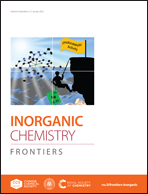Regulating the lattice strain of platinum–copper catalysts for enhancing collaborative electrocatalysis†
Abstract
The electrocatalytic activity of nanoalloy catalysts could be effectively manipulated by tuning their intrinsic physical and chemical properties (e.g., compositions, facets, lattice strain, morphologies, etc.). However, it still remains a challenge how to integrate these beneficial physical and chemical properties to promote the electrocatalytic performances for anode and cathode reactions in fuel cells. Herein, highly catalytic PtnCu100−n catalysts with many active sites were synthesized through optimizing the compositions of precursors and reaction conditions and a surfactant-free thermal solvent method, which showed a subtle lattice strain. Transmission electron microscopy and X-ray diffraction results revealed that the lattice strain of PtnCu100−n alloy nanostellates could be modulated by the alloy compositions. Electrochemical results showed that the high catalytic activity of PtnCu100−n alloy nanostellate catalysts for both the oxygen reduction and alcohol oxidation reactions was related to lattice shrinkage, facets and bimetallic compositions. Interestingly, Pt69Cu31/C nanostellate catalysts with lattice shrinking revealed the maximum activity and stability compared with other compositions and commercial Pt/C, which was also supported by DFT results. This study will provide a new path for the design of robust and active nanoalloy catalysts with lattice mismatch and dominant active facets for both the cathode and anode reactions in fuel cells.



 Please wait while we load your content...
Please wait while we load your content...